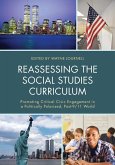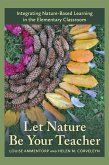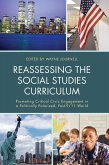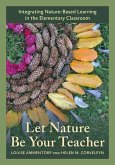- Broschiertes Buch
- Merkliste
- Auf die Merkliste
- Bewerten Bewerten
- Teilen
- Produkt teilen
- Produkterinnerung
- Produkterinnerung
This book highlights the critical importance of what it means to thoughtfully teach, emphasizing that a central aspect toward transformation in education is through the dedicated efforts of thoughtful teachers.
Andere Kunden interessierten sich auch für
![The Thoughtful Teacher The Thoughtful Teacher]() James D. KiryloThe Thoughtful Teacher102,99 €
James D. KiryloThe Thoughtful Teacher102,99 €![Reassessing the Social Studies Curriculum Reassessing the Social Studies Curriculum]() Reassessing the Social Studies Curriculum49,99 €
Reassessing the Social Studies Curriculum49,99 €![Let Nature Be Your Teacher Let Nature Be Your Teacher]() Louise AmmentorpLet Nature Be Your Teacher101,99 €
Louise AmmentorpLet Nature Be Your Teacher101,99 €![Reassessing the Social Studies Curriculum Reassessing the Social Studies Curriculum]() Reassessing the Social Studies Curriculum93,99 €
Reassessing the Social Studies Curriculum93,99 €![Let Nature Be Your Teacher Let Nature Be Your Teacher]() Louise AmmentorpLet Nature Be Your Teacher38,99 €
Louise AmmentorpLet Nature Be Your Teacher38,99 €![Teacher Resources for Thrown to the Wind Teacher Resources for Thrown to the Wind]() Amanda CetasTeacher Resources for Thrown to the Wind43,99 €
Amanda CetasTeacher Resources for Thrown to the Wind43,99 €![Culture, Language, and Curricular Choices Culture, Language, and Curricular Choices]() Culture, Language, and Curricular Choices49,99 €
Culture, Language, and Curricular Choices49,99 €-
-
-
This book highlights the critical importance of what it means to thoughtfully teach, emphasizing that a central aspect toward transformation in education is through the dedicated efforts of thoughtful teachers.
Hinweis: Dieser Artikel kann nur an eine deutsche Lieferadresse ausgeliefert werden.
Hinweis: Dieser Artikel kann nur an eine deutsche Lieferadresse ausgeliefert werden.
Produktdetails
- Produktdetails
- Verlag: Rowman & Littlefield Publishers
- Seitenzahl: 242
- Erscheinungstermin: 15. April 2021
- Englisch
- Abmessung: 229mm x 152mm x 14mm
- Gewicht: 399g
- ISBN-13: 9781475855289
- ISBN-10: 1475855281
- Artikelnr.: 60597831
- Herstellerkennzeichnung
- Libri GmbH
- Europaallee 1
- 36244 Bad Hersfeld
- gpsr@libri.de
- Verlag: Rowman & Littlefield Publishers
- Seitenzahl: 242
- Erscheinungstermin: 15. April 2021
- Englisch
- Abmessung: 229mm x 152mm x 14mm
- Gewicht: 399g
- ISBN-13: 9781475855289
- ISBN-10: 1475855281
- Artikelnr.: 60597831
- Herstellerkennzeichnung
- Libri GmbH
- Europaallee 1
- 36244 Bad Hersfeld
- gpsr@libri.de
James D. Kirylo is professor of education at the University of South Carolina. His books include Paulo Freire: The Man from Recife and Reinventing Pedagogy of the Oppressed, among other books and articles in a variety of professional journals.
PREFACE TO THE SECOND EDITION
PREFACE TO THE FIRST EDITION
ACKNOWLEDGMENTS
INTRODUCTION
SECTION I: FROM THE INSIDE OUT
Chapter 1: An Earned Privilege
Chapter 2: Establishing a Philosophy of Education
Chapter 3: The Decisive Relevance of Dispositions: Reconciling the Private
with the Public
Chapter 4: A Certain Spirituality of Inclusion
Chapter 5: Six Dispositions of Significance
Chapter 6: Reflective Thinking-Thoughtful Action
SECTION II: ENTERING INTO RELATIONSHIPS
Chapter 7: Hardwired to be in Relationship: A Thing of the Brain
Chapter 8: Fostering the Teacher-Student Relationship: From Right Where
They Are
Chapter 9: Cultivating Dialogue
Chapter 10: The Flow of Integrity
Chapter 11: Other Relationships: Parents/Caregivers, Colleagues, and the
Wider Community
Chapter 12: To be in Relationship is to Celebrate Diversity
SECTION III: THE GOAL IS TO INSPIRE (AN ARTISTIC ENDEAVOR)
Chapter 13: The Character of Inspiration
Chapter 14: Inspiration and the Autobiographical Nature of Teaching
Chapter 15: Inspiration Leads to an Artistic Act
SECTION IV: THE GLUE THAT IS EDUCATIONAL PSYCHOLOGY
Chapter 16: The Critical Relevance of Theory
Chapter 17: Paving the way Toward Child/Developmental Psychology: John
Locke and Jean-Jacques Rousseau
Chapter 18: An Overview: Behaviorism, Cognitivism, and Humanism
Chapter 19: Educational Psychology, Practice, and the Voices of Women and
People of Color
SECTION V: FIVE COMPONENTS OF KNOWLEDGE
Chapter 20: Knowledge of Pedagogy and Knowledge of Classroom Management
Chapter 21: Knowledge of Learning, Knowledge of Students, and Knowledge of
Subject Matter
SECTION VI: ASSESSMENT IS TO "SIT WITH"
Chapter 22: Two Different Processes: Assessment and Evaluation
Chapter 23: The Advent of a Testing Movement
Chapter 24: Moving into an Era of High-Stakes Testing
Chapter 25: The Resistance to Standardized Tests
Chapter 26: Emphasizing Formative and Portfolio Assessments
SECTION VII: TEACHER LEADERSHIP AND THE CHALLENGES
Chapter 27: Teacher as Leader
Chapter 28: Teacher Leadership and the Challenge of Poverty
Chapter 29: Teacher Leadership and Confronting a Culture of Violence: The
Scourge of School Shootings and Bullying
Chapter 30: And How Are the Children?
APPENDICES
Appendix A: Derivative and Historical Unfolding of Inspiration
Appendix B: A Response to the Tylerian Rationale
REFERENCES
PREFACE TO THE FIRST EDITION
ACKNOWLEDGMENTS
INTRODUCTION
SECTION I: FROM THE INSIDE OUT
Chapter 1: An Earned Privilege
Chapter 2: Establishing a Philosophy of Education
Chapter 3: The Decisive Relevance of Dispositions: Reconciling the Private
with the Public
Chapter 4: A Certain Spirituality of Inclusion
Chapter 5: Six Dispositions of Significance
Chapter 6: Reflective Thinking-Thoughtful Action
SECTION II: ENTERING INTO RELATIONSHIPS
Chapter 7: Hardwired to be in Relationship: A Thing of the Brain
Chapter 8: Fostering the Teacher-Student Relationship: From Right Where
They Are
Chapter 9: Cultivating Dialogue
Chapter 10: The Flow of Integrity
Chapter 11: Other Relationships: Parents/Caregivers, Colleagues, and the
Wider Community
Chapter 12: To be in Relationship is to Celebrate Diversity
SECTION III: THE GOAL IS TO INSPIRE (AN ARTISTIC ENDEAVOR)
Chapter 13: The Character of Inspiration
Chapter 14: Inspiration and the Autobiographical Nature of Teaching
Chapter 15: Inspiration Leads to an Artistic Act
SECTION IV: THE GLUE THAT IS EDUCATIONAL PSYCHOLOGY
Chapter 16: The Critical Relevance of Theory
Chapter 17: Paving the way Toward Child/Developmental Psychology: John
Locke and Jean-Jacques Rousseau
Chapter 18: An Overview: Behaviorism, Cognitivism, and Humanism
Chapter 19: Educational Psychology, Practice, and the Voices of Women and
People of Color
SECTION V: FIVE COMPONENTS OF KNOWLEDGE
Chapter 20: Knowledge of Pedagogy and Knowledge of Classroom Management
Chapter 21: Knowledge of Learning, Knowledge of Students, and Knowledge of
Subject Matter
SECTION VI: ASSESSMENT IS TO "SIT WITH"
Chapter 22: Two Different Processes: Assessment and Evaluation
Chapter 23: The Advent of a Testing Movement
Chapter 24: Moving into an Era of High-Stakes Testing
Chapter 25: The Resistance to Standardized Tests
Chapter 26: Emphasizing Formative and Portfolio Assessments
SECTION VII: TEACHER LEADERSHIP AND THE CHALLENGES
Chapter 27: Teacher as Leader
Chapter 28: Teacher Leadership and the Challenge of Poverty
Chapter 29: Teacher Leadership and Confronting a Culture of Violence: The
Scourge of School Shootings and Bullying
Chapter 30: And How Are the Children?
APPENDICES
Appendix A: Derivative and Historical Unfolding of Inspiration
Appendix B: A Response to the Tylerian Rationale
REFERENCES
PREFACE TO THE SECOND EDITION
PREFACE TO THE FIRST EDITION
ACKNOWLEDGMENTS
INTRODUCTION
SECTION I: FROM THE INSIDE OUT
Chapter 1: An Earned Privilege
Chapter 2: Establishing a Philosophy of Education
Chapter 3: The Decisive Relevance of Dispositions: Reconciling the Private
with the Public
Chapter 4: A Certain Spirituality of Inclusion
Chapter 5: Six Dispositions of Significance
Chapter 6: Reflective Thinking-Thoughtful Action
SECTION II: ENTERING INTO RELATIONSHIPS
Chapter 7: Hardwired to be in Relationship: A Thing of the Brain
Chapter 8: Fostering the Teacher-Student Relationship: From Right Where
They Are
Chapter 9: Cultivating Dialogue
Chapter 10: The Flow of Integrity
Chapter 11: Other Relationships: Parents/Caregivers, Colleagues, and the
Wider Community
Chapter 12: To be in Relationship is to Celebrate Diversity
SECTION III: THE GOAL IS TO INSPIRE (AN ARTISTIC ENDEAVOR)
Chapter 13: The Character of Inspiration
Chapter 14: Inspiration and the Autobiographical Nature of Teaching
Chapter 15: Inspiration Leads to an Artistic Act
SECTION IV: THE GLUE THAT IS EDUCATIONAL PSYCHOLOGY
Chapter 16: The Critical Relevance of Theory
Chapter 17: Paving the way Toward Child/Developmental Psychology: John
Locke and Jean-Jacques Rousseau
Chapter 18: An Overview: Behaviorism, Cognitivism, and Humanism
Chapter 19: Educational Psychology, Practice, and the Voices of Women and
People of Color
SECTION V: FIVE COMPONENTS OF KNOWLEDGE
Chapter 20: Knowledge of Pedagogy and Knowledge of Classroom Management
Chapter 21: Knowledge of Learning, Knowledge of Students, and Knowledge of
Subject Matter
SECTION VI: ASSESSMENT IS TO "SIT WITH"
Chapter 22: Two Different Processes: Assessment and Evaluation
Chapter 23: The Advent of a Testing Movement
Chapter 24: Moving into an Era of High-Stakes Testing
Chapter 25: The Resistance to Standardized Tests
Chapter 26: Emphasizing Formative and Portfolio Assessments
SECTION VII: TEACHER LEADERSHIP AND THE CHALLENGES
Chapter 27: Teacher as Leader
Chapter 28: Teacher Leadership and the Challenge of Poverty
Chapter 29: Teacher Leadership and Confronting a Culture of Violence: The
Scourge of School Shootings and Bullying
Chapter 30: And How Are the Children?
APPENDICES
Appendix A: Derivative and Historical Unfolding of Inspiration
Appendix B: A Response to the Tylerian Rationale
REFERENCES
PREFACE TO THE FIRST EDITION
ACKNOWLEDGMENTS
INTRODUCTION
SECTION I: FROM THE INSIDE OUT
Chapter 1: An Earned Privilege
Chapter 2: Establishing a Philosophy of Education
Chapter 3: The Decisive Relevance of Dispositions: Reconciling the Private
with the Public
Chapter 4: A Certain Spirituality of Inclusion
Chapter 5: Six Dispositions of Significance
Chapter 6: Reflective Thinking-Thoughtful Action
SECTION II: ENTERING INTO RELATIONSHIPS
Chapter 7: Hardwired to be in Relationship: A Thing of the Brain
Chapter 8: Fostering the Teacher-Student Relationship: From Right Where
They Are
Chapter 9: Cultivating Dialogue
Chapter 10: The Flow of Integrity
Chapter 11: Other Relationships: Parents/Caregivers, Colleagues, and the
Wider Community
Chapter 12: To be in Relationship is to Celebrate Diversity
SECTION III: THE GOAL IS TO INSPIRE (AN ARTISTIC ENDEAVOR)
Chapter 13: The Character of Inspiration
Chapter 14: Inspiration and the Autobiographical Nature of Teaching
Chapter 15: Inspiration Leads to an Artistic Act
SECTION IV: THE GLUE THAT IS EDUCATIONAL PSYCHOLOGY
Chapter 16: The Critical Relevance of Theory
Chapter 17: Paving the way Toward Child/Developmental Psychology: John
Locke and Jean-Jacques Rousseau
Chapter 18: An Overview: Behaviorism, Cognitivism, and Humanism
Chapter 19: Educational Psychology, Practice, and the Voices of Women and
People of Color
SECTION V: FIVE COMPONENTS OF KNOWLEDGE
Chapter 20: Knowledge of Pedagogy and Knowledge of Classroom Management
Chapter 21: Knowledge of Learning, Knowledge of Students, and Knowledge of
Subject Matter
SECTION VI: ASSESSMENT IS TO "SIT WITH"
Chapter 22: Two Different Processes: Assessment and Evaluation
Chapter 23: The Advent of a Testing Movement
Chapter 24: Moving into an Era of High-Stakes Testing
Chapter 25: The Resistance to Standardized Tests
Chapter 26: Emphasizing Formative and Portfolio Assessments
SECTION VII: TEACHER LEADERSHIP AND THE CHALLENGES
Chapter 27: Teacher as Leader
Chapter 28: Teacher Leadership and the Challenge of Poverty
Chapter 29: Teacher Leadership and Confronting a Culture of Violence: The
Scourge of School Shootings and Bullying
Chapter 30: And How Are the Children?
APPENDICES
Appendix A: Derivative and Historical Unfolding of Inspiration
Appendix B: A Response to the Tylerian Rationale
REFERENCES








